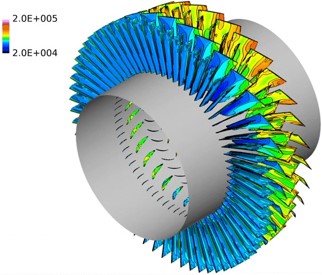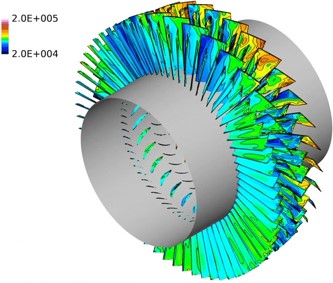Newsletter 2023.11 Index
Theme : "Mechanical Engineering Congress, 2023 Japan (MECJ-23)"
|
Toward Digital Twin Numerical Turbine
Abstract

Satoru YAMAMOTO,
|
As one of my works within past 40 years’ research, Digital Twin Numerical Turbine (DTNT) was successfully developed. Numerical Turbine (NT) can simulate full-annulus flows through a gas turbine compressor and a steam turbine considering moist air and wet steam. Recently, NT was applied to the simulation of full-annulus flows of a real gas turbine compressor under partial-load operation at a power plant. Fig. 1 represents the simulated instantaneous pressures on whole blade surfaces assuming full-load and partial-load operations. A stable flow was obtained in the case of full-load operation, whereas an unstable flow with stall cells was captured in the case of partial-load operation. The results indicate that the current partial-load operation to suppress the total electric power exceeded by solar-power generation may reduce the lifetime of gas turbines. DTNT finally forms a Self-Organizing Map (SOM) created by machine learning from hundreds of time-dependent data obtained from dozens of NT simulations setting different flow conditions. Fig. 2 shows the schematic of the process forming SOM from the NT simulations. The cases in the dotted line were supposed to be abnormal cases, clustering successfully. The most effective contribution to achieve the process was the significant reduction of computational time. Currently only 1.3 days are spent for one simulation of a full-annulus flow in 1.5-stage compressor using the supercomputer AOBA (SX-Arora Tsubasa) at Tohoku university. The activities of this work were reported by news medium in Oct. 2021 and June 2023. It is expected that normal and abnormal flow conditions of compressor operation can be predicted by the SOM at the design and in the operation.
Key words
CFD, Gas Turbine, Compressor, Numerical Turbine, Digital Twin
Figures
 |
 |
| Fig. 1 Instantaneous pressure distributions on whole blade surfaces (Left:Full load,Right:Partial load) |
|

Fig. 2 Data Clustering by Self-Organizing Map (SOM)

